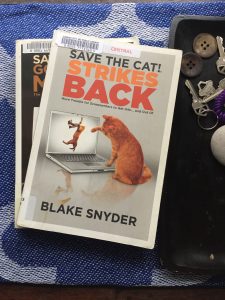Subscribe: Apple Podcasts | Email | RSS | More

How Blake Snyder's beat sheets can help us structure our personal histories
C. David Milles is a teacher by day and author by night. After stumbling onto Blake Snyder’s Save the Cat! books, Milles began to incorporate the screenwriter’s lessons in his novels and the way he taught middle school English. His keen understanding of story structure landed him a gig as a contributor for the popular Save the Cat! website, where Cory breaks down components of current and past movies to show their inner workings—a great exercise for storytellers in all media. In this episode, he shares how the Save the Cat! system can help us find the story structure in our personal history books.
Listen as we discuss:
Save the Cat's 10 genres
- Golden Fleece
- Buddy Love
- Suprehero
- Monster in the House
- Fool Triumphant
- Dude with a Problem
- Out of the Bottle
- Whydunit
- Institutionalized
- Rites of Passage
For an overview of what each genre is, check out the Save the Cat! site here, or to listen, here.
What kind of story are you telling?
By deciding on your genre (as the term is used by Blake Snyder), or a combination of genres, you can zero in on the necessary elements to keep your story humming along. This will also help you recognize where elements are missing and where your story sags.
15 Beats of the Beat Sheet
- Opening Image

- Set-up
- Theme Stated
- Catalyst
- Debate
- Break into Two (Act Two)
- B Story
- Promise of the Premise
- Midpoint
- Bad Guys Close In
- All is Lost
- Dark Night of the Soul
- Break into Three (Act Three)
- Finale
- Final Image
Milles walks through some of the "beats" (plot points) and explains their function in stories.
For example:
Opening image—tells what the story will be about: scope, setting, tone, mood. It gives us a glimpse of the main character before the changes to come.
Theme stated—for example, someone may wish for something. This sets up the character transformation to come.
Set-up—sets the stage for the reader by introducing the main characters and setting and all the pieces the reader needs to understand the story. A good hint for personal history interviews: When our storytellers are lost in memories, we need to remind them that we—and future readers—need details to ground us in the scene they are describing. We don’t know what it was like at your grandmother’s house or back at camp.
Catalyst—kicks off the character’s journey into change; a key moment that changes everything.
Debate—how the character reacts to this change. For life stories, this is where we find out how our storyteller felt about a turning point in life. [Hint: As a general rule, women are in tune to how an event made them feel; men may respond better when asked what they learned from an experience.]
Break into (act) two—taking an active step into this new reality.
B story—the subplot; is often another person to help the main character with the theme (getting what they want or need). This can be more than one person, a relative, etc.
Mid-point—Cory’s favorite part of the story; character thinks they’re getting what they want, but it’s a false victory. Things seem to be going great, but not really.
Bad Guys Close In—main character realizes things are going to get worse, they’ll be broken down.
All is lost moment—when the main character hits bottom; the “whiff of death”; whatever they’ve been trying hasn’t been working. This is the part of the story where the audience/reader gets teary-eyed.
Dark night of the soul—when the protagonist learns the main lesson.
Break into (act) three
Climax—problem is finally solved
Final image—shows what has happened to the protagonist after the journey.
Blake Snyder's Transformation Machine
We talk about the three acts as three worlds:
thesis world—life at the commencement of the story
antithesis world —the upside version of life as they know it
synthesis world—the new reality in which the character has changed as result of the journey
We also discuss:
- What we can learn about story structure from Pixar movies
- The difference between story structure and a formulaic story
- How evolution has wired us to understand stories (it's a matter of survival!)
- Even commercials and movie trailers incorporate the elements of story
- 40 scenes in three acts
- How alternating between internal and external events can increase tension
Gertrude Bell, and what we can learn from biography
Gertrude Bell was an important statesman and adventurer, and one of my current fascinations. Examining the Georgina Howell biography, Gertrude Bell: Queen of the Desert, Shaper of Nations , and comparing it to the online archives of Bell's letters and diaries, found here, is its own lesson in writing biography. It's not exactly the kind of writing we do as personal historians, but there's overlap. And where there's overlap, there are things we can learn.
It's all about character development
In the end, every story must show that a character develops. Finding a distinct narrative arc in personal history books might not be easy or straightforward, but we have one thing going for us: Every storyteller has developed over the course of his or her lifetime. It's part of our job (and a fun part, too) to figure out how to best highlight this transformation. Understanding story structure helps us do that.
Where to find C. David Milles
Reach out to today's guest via his website at cdavidmilles.com, on Facebook at C. David Milles Writer or browse for his beat sheets on the Save the Cat website. And make sure to check out his novels listed below.
If you liked this episode, please leave us a review on iTunes. Thanks for listening!
Now go out and save someone's story.









